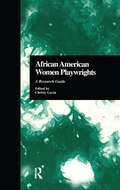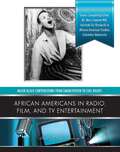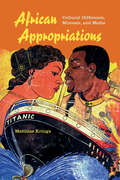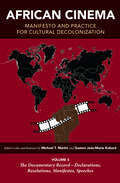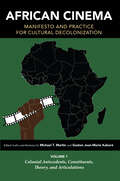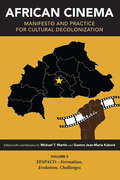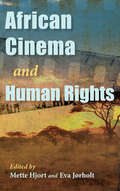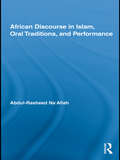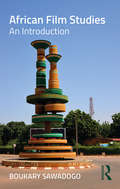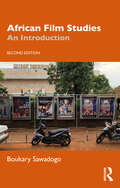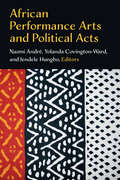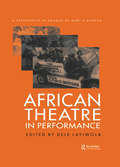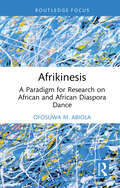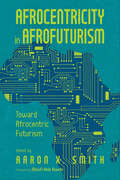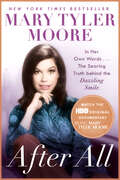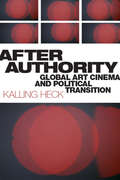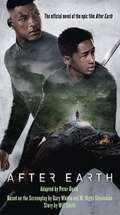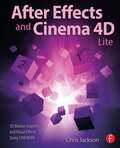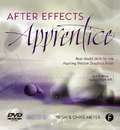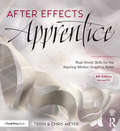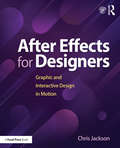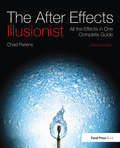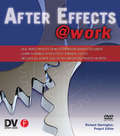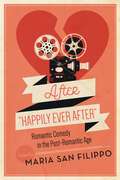- Table View
- List View
African American Women Playwrights: A Research Guide (Critical Studies in Black Life and Culture #31)
by Christy GavinFirst Published in 1999. Routledge is an imprint of Taylor & Francis, an informa company.
African Americans in Radio, Film, and TV Entertainers (Major Black Contributions from Emancipat)
by Linda J. ArmstrongThis book is filled with fascinating stories, from the night a shy young woman's play changed Broadway to the day the most successful talk show host in history got her start. Find out about the stage actor who once earned letters in four college sports--and who won academic honors, too. Follow the triumphs and disappointments of some of the most famous black entertainers in our nation's history. Rediscover great personalities who have been forgotten. And learn about how the roles of black performers both changed with and helped changed American society.
African Appropriations: Cultural Difference, Mimesis, And Media
by Matthias KringsWhy would a Hollywood film become a Nigerian video remake, a Tanzanian comic book, or a Congolese music video? Matthias Krings explores the myriad ways Africans respond to the relentless onslaught of global culture. He seeks out places where they have adapted pervasive cultural forms to their own purposes as photo novels, comic books, songs, posters, and even scam letters. These African appropriations reveal the broad scope of cultural mediation that is characteristic of our hyperlinked age. Krings argues that there is no longer an "original" or "faithful copy," but only endless transformations that thrive in the fertile ground of African popular culture.
African Cinema: Volume 3: The Documentary Record—Declarations, Resolutions, Manifestos, Speeches (Studies in the Cinema of the Black Diaspora)
by Gaston Jean-Marie Kaboré Michael T. MartinChallenging established views and assumptions about traditions and practices of filmmaking in the African diaspora, this three-volume set offers readers a researched critique on black film. Volume Three of this landmark series on African cinema spans the past century and is devoted to the documentation of decoloniality in cultural policy in both Africa and the Black diaspora worldwide. A compendium of formal resolutions, declarations, manifestos, and programmatic statements, it chronologically maps the long history and trajectories of cultural policy in Africa and the Black Atlantic. Beginning with the 1920 declaration of the Rights of the Negro Peoples of the World, which anticipates cinema as we know it today, and the formal oppositional assertions—aspirational and practical. The first part of this work references formal statements that pertain directly to cultural policy and cinematic formations in Africa, while the next part addresses the Black diaspora. Each entry is chronologically ordered to account for when the statement was created, followed by where and in what context it was enunciated.
African Cinema: Volume 1: Colonial Antecedents, Constituents, Theory, and Articulations (Studies in the Cinema of the Black Diaspora)
by Gaston Jean-Marie Kaboré Michael T. Martin Roy Armes James E. Genova Femi Okiremuete Shaka James Burns Tom Rice Odile Goerg Med Hondo Férid Boughedir Haile Gerima Sada Niang Monique Mbeka Phoba Olivier Barlet Clyde R. Taylor Alexie Tcheuyap Esiaba Irobi Stephen A. Zacks Teshome H. Gabriel David Murphy Jude Akudinobi Maureen N. Eke Arnold Shepperson Keyan G. Tomaselli Paulin Soumanou Vieyra Boukary Sawadogo Claude Forest Samba Gadjigo Beti EllersonChallenging established views and assumptions about traditions and practices of filmmaking in the African diaspora, this three-volume set offers readers a researched critique on black film. Volume One of this landmark series on African cinema draws together foundational scholarship on its history and evolution. Beginning with the ideological project of colonial film to legitimize the economic exploitation and cultural hegemony of the African continent during imperial rule to its counter-historical formation and theorization. It comprises essays by film scholars and filmmakers alike, among them Roy Armes, Med Hondo, Fèrid Boughedir, Haile Gerima, Oliver Barlet, Teshome Gabriel, and David Murphy, including three distinct dossiers: a timeline of key dates in the history of African cinema; a comprehensive chronicle and account of the contributions by African women in cinema; and a homage and overview of Ousmane Sembène, the "Father" of African cinema.
African Cinema: Volume 2: FESPACO—Formation, Evolution, Challenges (Studies in the Cinema of the Black Diaspora)
by Ardiouma Soma Michael T. Martin Gaston Jean-Marie Kaboré Lindiwe Dovey Manthia Diawara Beti Ellerson Sambolgo Bangre Dorothee Wenner M. Africanus Aveh Mahir Saul Mbye Cham Ousmane Sembene Wole Soyinka Aboubakar Sanogo Teresa Hoefert de Turegano Claire Andrade-Watkins Olivier Barlet Rod Stoneman Férid Boughedir Claire Diao Michel Amarger Mustapha Ouedgraogo Colin Dupré Sheila Petty Imruh Bakari June Givanni Rémi AbegaChallenging established views and assumptions about traditions and practices of filmmaking in the African diaspora, this three-volume set offers readers a researched critique on black film.Volume Two of this landmark series on African cinema is devoted to the decolonizing mediation of the Pan African Film & Television Festival of Ouagadougou (FESPACO), the most important, inclusive, and consequential cinematic convocation of its kind in the world. Since its creation in 1969, FESPACO's mission is, in principle, remarkably unchanged: to unapologetically recover, chronicle, affirm, and reconstitute the representation of the African continent and its global diasporas of people, thereby enunciating in the cinematic, all manner of Pan-African identity, experience, and the futurity of the Black World. This volume features historically significant and commissioned essays, commentaries, conversations, dossiers, and programmatic statements and manifestos that mark and elaborate the key moments in the evolution of FESPACO over the span of the past five decades.
African Cinema and Human Rights (Studies In The Cinema Of The Black Diaspora Ser.)
by Edited by Mette Hjort and Eva JørholtEssays and case studies exploring how filmmaking can play a role in promoting social and economic justice. Bringing theory and practice together, African Cinema and Human Rights argues that moving images have a significant role to play in advancing the causes of justice and fairness. The contributors to this volume identify three key ways in which film can achieve these goals: Documenting human rights abuses and thereby supporting the claims of victims and goals of truth and reconciliation within larger communitiesLegitimating, and consequently solidifying, an expanded scope for human rightsPromoting the realization of social and economic right Including the voices of African scholars, scholar-filmmakers, African directors Jean-Marie Teno and Gaston Kaboré, and researchers whose work focuses on transnational cinema, this volume explores overall perspectives, and differences of perspective, pertaining to Africa, human rights, and human rights filmmaking alongside specific case studies of individual films and areas of human rights violations. With its interdisciplinary scope, attention to practitioners&’ self-understandings, broad perspectives, and particular case studies, African Cinema and Human Rights is a foundational text that offers questions, reflections, and evidence that help us to consider film&’s ideal role within the context of our ever-continuing struggle towards a more just global society.
African Discourse in Islam, Oral Traditions, and Performance (African Studies)
by Abdul-Rasheed Na'AllahThrough an engaged analysis of writers such as Wole Soyinka, Ola Rotimi, Niyi Osundare, and Tanure Ojaide and of African traditional oral poets like Omoekee Amao Ilorin and Mamman Shata Katsina, Abdul-Rasheed Na'Allah develops an African indigenous discourse paradigm for interpreting and understanding literary and cultural materials. Na'Allah argues for the need for cultural diversity in critical theorizing in the twenty-first century. He highlights the critical issues facing scholars and students involved in criticism and translation of marginalized texts. By returning the African knowledge system back to its roots and placing it side by side with Western paradigms, Na'Allah has produced a text that will be required reading for scholars and students of African culture and literature. It is an important contribution to scholarship in the domain of mobility of African oral tradition, and on African literary, cultural and performance discourse.
African Film Studies: An Introduction
by Boukary Sawadogo<p>African Film Studies: An Introduction is an accessible and authoritative textbook on African cinema as a field of study. The book provides a succinct and comprehensive study of the history, aesthetics, and theory of sub-Saharan African cinematic productions that is grounded in the field of film studies instead of textual interpretations from other disciplines. <p>Bringing African cinema out of the margins into the discipline of mainstream film studies and showcasing the diverse cinematic expressions of the continent, the book covers: <p> <li>Overview of African cinema(s): Questions our assumptions about the continent’s cinematic productions and defines the characteristics of African cinema across linguistic, geographic, and filmic divides. <li>History of African and African-American cinema: Spans the history of film in Africa from colonial import and ‘appropriation of the gaze’ to the quest for individuality. It also establishes parallels in the historical development of black African cinema and African-American cinema. <li>Aesthetics: Introduces new research on previously unexplored aesthetic dimensions such as cinematography, animation, and film music. <li>Theoretical Approaches: Addresses a number of theoretical approaches and critical frameworks developed by scholars in the study of African cinema <p> <p>All chapters include case studies, suggestions for further reading, and screening lists to deepen the reader’s knowledge with no prior knowledge of African cinema required. Students, teachers, and general film enthusiasts would all benefit from this accessible and engaging book.</p>
African Film Studies: An Introduction
by Boukary SawadogoAfrican Film Studies is an accessible and engaging introduction to African cinemas, showcasing the diverse cinematic expressions across the continent. Bringing African cinemas out of the margins and into mainstream film studies, the book provides a succinct overview of the history, aesthetics, and theory of sub-Saharan African cinematic productions. Updated throughout, this new edition includes new chapters on Nollywood, Ethiopian cinema, Streaming, and the rise of televisual series, which serve to complement the book’s main themes: • Overview of African cinema(s): Questions assumptions and defines the characteristics of African cinemas across linguistic, geographic, and filmic divides. • History of African cinemas: Spans the history of film in Africa from colonial import and ‘appropriation of the gaze’, the rise of Nollywood and local TV series to streaming, as well as building connections with the development of African American cinema. • Aesthetics: Introduces new research on previously under-explored aesthetic dimensions such as cinematography, animation, and film music. • Theoretical Approaches: Addresses a number of theoretical approaches and critical frameworks developed by scholars in the study of African cinemas. • Traditions and practices in African screen media: Features Ethiopian cinema, Nollywood, Local Televisual Series in Burkina Faso and South Africa, and the Streaming rush for Africa. All chapters include case studies, suggestions for further reading, and screening lists to deepen the reader’s knowledge, with no prior knowledge of African cinemas required. Students, teachers, and general film enthusiasts would all benefit from this accessible and engaging book.
African Performance Arts and Political Acts (African Perspectives)
by Naomi Andre Yolanda Covington-Ward Jendele HungboAfrican Performance Arts and Political Actspresents innovative formulations for how African performance and the arts shape the narratives of cultural history and politics. This collection, edited by Naomi André, Yolanda Covington-Ward, and Jendele Hungbo, engages with a breadth of African countries and art forms, bringing together speech, hip hop, religious healing and gesture, theater and social justice, opera, radio announcements, protest songs, and migrant workers’ dances. The spaces include village communities, city landscapes, prisons, urban hostels, Township theaters, opera houses, and broadcasts through the airwaves on television and radio as well as in cyberspace. Essays focus on case studies from Cameroon, the Democratic Republic of the Congo, Nigeria, Senegal, South Africa, and Tanzania.
African Theatre in Performance: A Festschrift in Honour of Martin Banham (Contemporary Theatre Studies #Vol. 35)
by Dele LayiwolaIn this lively and varied tribute to Martin Banham, Layiwola has assembled critical commentaries and two plays which focus primarily on Nigerian theatre - both traditional and contemporary. Dele Layiwola, Dapo Adelugba and Sonny Oti trace the beginnings of the School of Drama in 1960, at the University of Ibadan, Nigeria, where Martin Banham played a key and influential role in the growth of thriving Nigerian theatre repetoire and simulaneously encouraging the creation of a new theatre based on traditional Nigerian theatre forms.This comparative approach is taken up in Dele Layiwola's study of ritual and drama in the context of various traditions worldwide, while Oyin Ogunba presents a lucid picture of the complex use of theatre space in Yoruba ritual dramadar drama.Harsh everyday realitites, both physical and political, are graphically demonstrated by Robert McClaren (Zimbabwe) and Oga Steve Abah (Nigeria) who both show surprising and alarming links between extreme actual experiences and theatre creation and performance. The texts of the two plays - When Criminals Turn Judges by Ola Rotimi, The Hand that Feeds the King by Wale Ogunyemi, are followed by Austin O. Asagba's study of oral tradition and text in plays by Osofisan and Agbeyegbe, and Frances Harding's study on power, language, and imagery in Wole Soyinka's plays.
Afrikinesis: A Paradigm for Research on African and African Diaspora Dance (Routledge Advances in Theatre & Performance Studies)
by Ofosuwa M AbiolaThis book provides scholars and non-specialists alike with a roadmap for effectively conducting culturally aware, historically relevant research on African dance and on any dance style that contains African elements. This book explains why Western research paradigms are inadequate for research on Africana dance. It exposes the value of utilizing an appropriate research paradigm that offers researchers a broader perspective and a transparent, unfettered process for analysis in under-researched topics such as African and African diaspora dance styles. Researchers are introduced to the African dance aesthetic, characteristically African body movements, definitions of steps, understandings within African culture, and a host of other jewels that facilitate a deeper grasp on the subject and refine the quality of the scholar’s research, its findings, and its proficiency. This book will be of great interest to scholars of African dance studies.
Afrocentricity in AfroFuturism: Toward Afrocentric Futurism
by Aaron X. SmithContributions by Taharka Adé, Molefi Kete Asante, Alonge O. Clarkson, John P. Craig, Ifetayo M. Flannery, Kofi Kubatanna, Lehasa Moloi, M. Ndiika Mutere, and Aaron X. SmithIn the twenty-first century, AfroFuturism—a historical and philosophical concept of the future imagined through a Black cultural lens—has been interpreted through a myriad of writers, artists, scientists, and other visionary creatives. In Afrocentricity in AfroFuturism: Toward Afrocentric Futurism, editor Aaron X. Smith curates a collection of interdisciplinary essays that critiques existing scholarship on Black futurity. In contrast to much previous work, these essays ground their explorations in African agency, centering the African within historical and cultural reality. Situating Afrocentricity as the field’s foundational root and springboard for an expansive future, contributors detail potential new modes of existence and expression for African people throughout the diaspora.Divided into two parts—Representations and Transformations—this book examines the tensions created by historical and cultural dislocation of African peoples and consciousness. Contributors cover varied topics such as the intersections of culture and design; techno culture; neuroscience; and the multiplicity of African cultural influences in aesthetics, oratory, visual art, hip hop, and more. Essays range from theoretical analyses to close readings of history and popular culture, from the Haitian Revolution to Sun Ra, Janelle Monáe’s Dirty Computer, and Black Panther. Afrocentricity in AfroFuturism offers an expansive vision of AfroFuturism and its ranging significance to contemporary culture and discourse.
After All: In Her Own Words . . . The Searing Truth behind the Dazzling Smile
by Mary Tyler MooreNew York Times Bestseller Audiences have long adored Mary Tyler Moore for her television persona as the quintessential girl-next-door, as well as for her strong performances on screen and stage. But what about the poignant doubts and inner strength that drove this versatile and courageous actress? After All is the candid, moving autobiography of the woman America fell in love with, and the icon she became. &“Mesmerizing…Fans will love Moore&’s behind-the-scenes reminiscences.&” —San Francisco Chronicle Mary Tyler Moore was America's darling: actress, producer, star of the golden age of television. Her work on The Dick Van Dyke Show and The Mary Tyler Moore Show garnered multiple Emmys, followed by critical acclaim for her acting on Broadway and in film. Now, in her witty, candid, heartbreaking autobiography, Mary Tyler Moore tells all about the Dick Van Dyke nobody knows; Elvis, her sly, seductive co-star in Change of Habit; how Carl Reiner taught her to cry while being funny; Robert Redford's confession after casting her in Ordinary People; about then-First Lady Betty Ford's inebriated debut on The Mary Tyler Moore Show, and years later, her phone call that saved Mary's life. After All is the exhilarating and moving story of this extraordinarily successful woman, a complex and creative star who hadn&’t developed a legacy without much pain and reflection along the way. Mary spares nothing as she recounts her traumatic childhood, two failed marriages, her own alcoholism, the tragic death of her son, and her third, happy marriage to a cardiologist eighteen years her junior. Offering a firsthand overview of the television industry, and peppered with sharp anecdotes, the result is a remarkable narrative and a rare look at one the most enduring and admired stars of our time. Inspiring, poignant, and brutally frank, After All will touch every reader's heart and soul.
After Austen: Reinventions, Rewritings, Revisitings
by Lisa HopkinsThis collection of twelve new essays examines some of what Jane Austen has become in the two hundred years since her death. Some of the chapters explore adaptations or repurposings of her work while others trace her influence on a surprising variety of different kinds of writing, sometimes even when there is no announced or obvious debt to her. In so doing they also inevitably shed light on Austen herself. Austen is often considered romantic and not often considered political, but both those perceptions are challenged her, as is the idea that she is primarily a writer for and about women. Her books are comic and ironic, but they have been reworked and drawn upon in very different genres and styles. Collectively these essays testify to the extraordinary versatility and resonance of Austen’s books.
After Authority: Global Art Cinema and Political Transition
by Kalling HeckAfter Authority explores the tendency in art cinema to respond to political transition by turning to ambiguity, a system that ideally stems the reemergence of authoritarian logics in art and elsewhere. By comparing films from Italy, Hungary, South Korea, and the United States, this book contends that the aesthetic tradition of ambiguity in art cinema can be traced to post-authoritarian conditions and that it is in the context of a transition away from authoritarianism where art cinema aesthetics become legible. Art cinema, then, can be seen as a mode of cinematic practice that is at its core political, as its constitutive ambiguity finds its roots in the rejection of centralized and hierarchical configurations of authority. Ultimately, After Authority proposes a history of art cinema predicated on the potentials, possibilities, and politics of ambiguity.
After Earth: The official novel of the epic film
by Peter DavidExperience the vast tapestry of After Earth in a novelization unlike any other: a thousand-year saga featuring original content from the mind of Peter David, the veteran sci-fi author who helped develop the richly imagined universe. This is the complete, never-before-seen chronicle of the extraordinary family that's been across the universe and back--from humanity's last days on Earth through the events of the epic film! RAIGE RUNS IN THE FAMILY General Cypher Raige of the United Ranger Corps is only the latest in a long line of heroes. For a thousand years, ever since the globe was engulfed by environmental apocalypse, the Raiges have been instrumental in humanity's survival. They led the way as the survivors abandoned Earth, settled an uninhabitable planet called Nova Prime, withstood an onslaught from a mysterious alien force, and carved out a new home in the farthest reaches of the galaxy. Now Cypher has returned to his family after an extended tour of duty. For his thirteen-year-old son, Kitai, tagging along with his famous father is the adventure of a lifetime--and a chance to salvage their relationship. But when an asteroid collides with their craft, they make a crash landing that leaves Cypher seriously--perhaps fatally--wounded. Kitai Raige has always wanted to prove that he has what it takes to live up to his illustrious name. Now, all too soon, he gets his chance. With his father's life on the line, Kitai must venture out into the strange, hostile terrain of a new world that seems eerily familiar: Earth.
After Effects and Cinema 4D Lite: 3D Motion Graphics and Visual Effects Using CINEWARE
by Chris JacksonOne of the most exciting new features in After Effects is the integration of Cinema 4D using the CINEWARE plug-in and a free version of Cinema 4D Lite. Both provide a wide assortment of new 3D tools and options that are difficult or nearly impossible to achieve in After Effects alone. This book clearly demonstrates how the new 3D workflow bridges the two applications together to raise the design bar for motion graphics and broadcast design. Hands-on exercises teach you essential production skills including: Modeling in CINEMA 4D Lite Importing 3D models in After Effects Tracking 3D motion in After Effects Compositing with CINEWARE Using MoGraph features in CINEMA 4D Rendering and optimization techniques Additional online materials include project files and videos showcasing the techniques covered in the book. To access these materials, please see the 'eResources' tab.
After Effects Apprentice,
by Chris Meyer Trish MeyerWhether you're new to After Effects and want to get up to speed quickly, or already a user who needs to become familiar with the new features, After Effects Apprentice was created for you. With 11 core lessons plus a final project that pulls it all together, you'll learn how to tap this program's vast potential - whether you create motion graphics for network television, corporate communications, or your own projects. Fully updated to cover the major new features introduced in After Effects CS6, CS5.5, and CS5, this edition of the book presents a professional perspective on the most important features a motion graphics artist needs to master in order to use After Effects effectively. You'll learn to creatively combine layers, animate eye-catching titles, manipulate 3D space, track or rotoscope existing footage to add new elements, color key and stabilize a shot to place it in a new environment, and use effects to generate excitement or enhance the realism of a scene. Easy to follow, step-by-step instructions guide you through the features, with explanations of the "why" instead of just the "how" behind each technique. You'll learn more than just the tools; you'll learn skills that you can immediately put to work expressing your own ideas in your productions. Topics include how to: Animate, edit, layer, and composite video and still images. Manipulate keyframes and the way they interpolate to create more refined animations. Use masks, mattes, stencils and blending modes to add sophistication to your imagery. Create and animate text and shape layers Place your layers in 3D space. Use tracking and keying to create special effects, such as replacing screen displays. DVD contains: All exercise source material and project files for After Effects CS6, CS5.5, and CS5, plus 90 minutes of video tutorials.
After Effects Apprentice: Real-World Skills for the Aspiring Motion Graphics Artist (Apprentice Series)
by Chris Meyer Trish MeyerWhether you’re new to After Effects and want to get up to speed quickly, or already a user who needs to become familiar with the new features, After Effects Apprentice was created for you. With 12 core lessons including a trio of projects combining After Effects with CINEMA 4D Lite, you’ll learn how to tap this program’s vast potential – whether you create motion graphics for network television, corporate communications, or your own projects. Fully updated to cover the major new features added in After Effects CC, this edition of the book presents a professional perspective on the most important features a motion graphics artist needs to master in order to use After Effects effectively. You’ll learn to creatively combine layers; animate eye-catching titles; manipulate 3D space; color key, track or rotoscope existing footage to add new elements; and use effects to generate excitement or enhance the realism of a scene. Easy to follow, step-by-step instructions guide you through the features, with explanations of the "why" instead of just the "how" behind each technique. You’ll learn more than just the tools; you’ll learn skills that you can immediately put to work expressing your own ideas in your productions. USER LEVEL: Novice–Intermediate Topics include how to: • Animate, edit, layer, and composite a variety of media. • Manipulate keyframes and the way they interpolate to create more refined animations. • Use masks, mattes, stencils and blending modes to add sophistication to your imagery. • Create, animate, and extrude text and shape layers. • Explore 3D space, including using CINEMA 4D Lite. • Use tracking and keying to create special effects, such as replacing screen displays. A companion website at www.routledge.com/cw/meyer makes available for download all exercise source material and After Effects CC project files required to get the most out of this book.
After Effects for Designers: Graphic and Interactive Design in Motion
by Chris JacksonAfter Effects for Designers teaches design students, artists, and web, graphic, and interactive designers how to design, develop, and deploy motion design projects using Adobe After Effects. Author Chris Jackson balances fundamental aspects of time-based design with related techniques, and explores the principles of animation; composition and layout; visual hierarchy; typography; cinematic storytelling; 3D modelling; compositing, and more. Each chapter contains unique, step-by-step project exercises that offer timesaving practical tips and hands-on design techniques, teaching readers how to effectively use the tools at their disposal in order to conceptualize and visualize creative solutions to their own motion design work. Readers will build professional-world examples in every chapter and, as a result, learn how to both design effectively using After Effects and practically apply these skills in client-based work. An accompanying companion website includes complete project files for the book's chapter exercises, and additional video tutorials.
The After Effects Illusionist: All the Effects in One Complete Guide (All The Effects In One Complete Guide Ser.)
by Chad PerkinsFirst published in 2012. Routledge is an imprint of Taylor & Francis, an informa company.
After Effects @ Work: DV Expert Series
by Richard HarringtonReal-World commercial projects presented in full color feature the work of renowned artists, Chris and Trish Meyer, Jayse Hansen, Mark Coleran, Ken Locsmandi and others. The tutorials are commercial projects that the artists created for a client budget of $10,000 or less, using only the plug-ins that come with the software. Special focus is given to the fundamental techniques that are important to novice motion graphic artists. The companion DVD contains the source files required for the reader to replicate the techniques as well as Apple QuickTime presentations of the final projects. The projects cover a wide range of practical applications including broadcast animation, big-screen film trailers, music video compositing, trade show presentations, DVD menu graphics, and cel animation with Flash.
After "Happily Ever After": Romantic Comedy in the Post-Romantic Age (Contemporary Approaches to Film and Media Series)
by Maria San Filippo Deborah Jermyn Martha Shearer John Alberti James MacDowell Tom Cunliffe Beatriz Oria Betty Kaklamanidou Mary Harrod Maya Montañez Smukler Elizabeth Alsop Alice Guilluy Ash Kinney D'Harcourt Tamar Jeffers MacDonald Sueyoung Park-Primiano Manuela RuizIn defiance of the alleged "death of romantic comedy," After "Happily Ever After": Romantic Comedy in the Post-Romantic Age edited by Maria San Filippo attests to rom-com’s continuing vitality in new modes and forms that reimagine and rejuvenate the genre in ideologically, artistically, and commercially innovative ways. No longer the idyllic fairy tale, today’s romantic comedies ponder the realities and complexities of intimacy, fortifying the genre’s gift for imagining human connection through love and laughter. It has often been observed that the rom-com’s "happily ever after" trope enables the genre to avoid addressing the challenges of coupled life. This volume’s contributors confront how recent rom-coms contend with a "post-romantic age" of romantic disillusionment and seismically shifting emotional and relational bonds. Fifteen chapters contemplate the resurgence of the "radical romantic comedy" and uncoupling comedy, new approaches in genre hybridity and serial narrative, and how recent rom-coms deal with divisive topical issues and contemporary sexual mores from reproductive politics and marriage equality to hook-up culture and technology-enabled sex. Rom-coms remain underappreciated and underexamined—and still largely defined within Hollywood’s parameters of culturally normative coupling and its persistent marginalization of racial and sexual minorities. Making the case for taking romantic comedy seriously, this volume employs critical perspectives drawn from feminist, queer, postcolonial, and race studies to critique the genre’s homogeneity and social and sexual conservatism, recognizing innovative works inclusive of LGBTQ people, people of color, and the differently aged and abled. Encompassing a rich range of screen media from the last decade, After "Happily Ever After" celebrates works that disrupt and subvert rom-com fantasy and formula so as to open audience’s eyes along with our hearts. This volume is intended for all readers with an interest in film, media, and gender studies.
